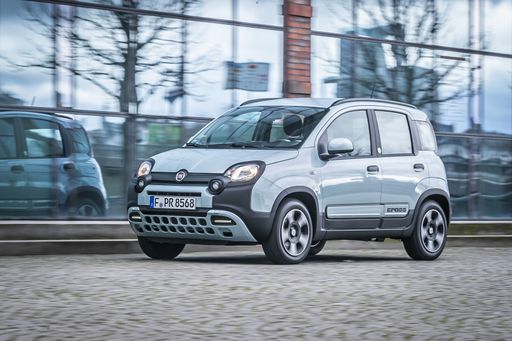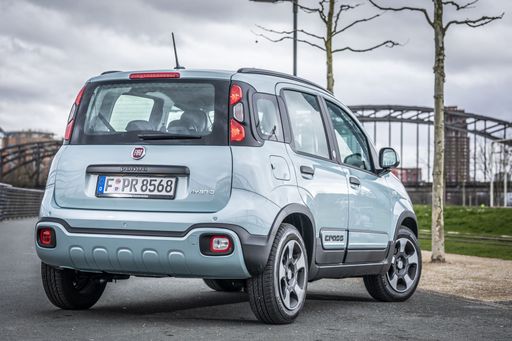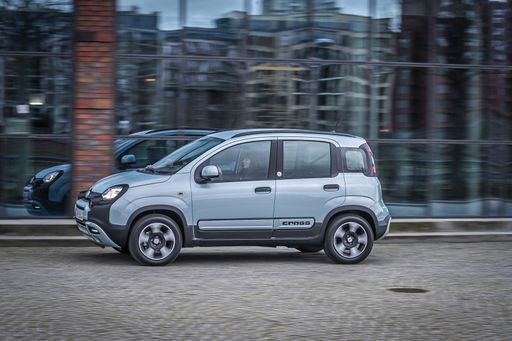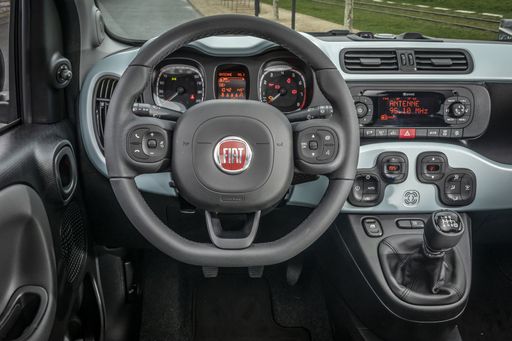Nissan Interstar VS Fiat Panda – Specs, Efficiency & Price Comparison
Which model is the better choice – the Nissan Interstar or the Fiat Panda? We compare performance (170 HP vs 70 HP), boot capacity ( vs 225 L), efficiency (7.40 L vs 5 L), and of course, the price (34900 £ vs 14100 £).
Find out now which car fits your needs better!
The Nissan Interstar (Cargo Van) is powered by a Diesel or Electric engine and comes with a Manuel or Automatic transmission. In comparison, the Fiat Panda (Hatchback) features a Petrol MHEV engine and a Manuel gearbox.
When it comes to boot capacity, the Nissan Interstar offers , while the Fiat Panda provides 225 L – depending on what matters most to you. If you’re looking for more power, you’ll need to decide whether the 170 HP of the Nissan Interstar or the 70 HP of the Fiat Panda suits your needs better.
There are also differences in efficiency: 7.40 L vs 5 L. In terms of price, the Nissan Interstar starts at 34900 £, while the Fiat Panda is available from 14100 £.
Compare all the key specs now and find out which model fits your lifestyle best!
Nissan Interstar
The Nissan Interstar is a versatile van that expertly combines practicality with modern design. It offers a spacious interior that caters to both cargo and passenger needs, making it ideal for businesses and families alike. With its robust performance and efficient fuel consumption, the Interstar stands out as a reliable choice in the commercial vehicle market.
detailsFiat Panda
The Fiat Panda is a compact city car that brilliantly combines practical design and efficient functionality. Its boxy shape provides ample interior space and visibility, making it a favourite among urban drivers. With its reputation for reliability and affordability, the Panda continues to be a top choice for those seeking a no-frills, dependable vehicle.
details @ media.stellantis.com
@ media.stellantis.com
 @ media.stellantis.com
@ media.stellantis.com
 @ media.stellantis.com
@ media.stellantis.com
 @ media.stellantis.com
@ media.stellantis.com

|
|
|
|
|
Costs and Consumption |
|
|---|---|
|
Price
34900 - 55600 £
|
Price
14100 - 17100 £
|
|
Consumption L/100km
7.4 - 7.5 L
|
Consumption L/100km
5 - 5.1 L
|
|
Consumption kWh/100km
-
|
Consumption kWh/100km
-
|
|
Electric Range
175 - 410 km
|
Electric Range
-
|
|
Battery Capacity
-
|
Battery Capacity
-
|
|
co2
0 - 195 g/km
|
co2
113 - 116 g/km
|
|
Fuel tank capacity
80 L
|
Fuel tank capacity
38 L
|
Dimensions and Body |
|
|---|---|
|
Body Type
Cargo Van
|
Body Type
Hatchback
|
|
Seats
3 - 7
|
Seats
4 - 5
|
|
Doors
4
|
Doors
5
|
|
Curb weight
2053 - 2535 kg
|
Curb weight
1055 kg
|
|
Trunk capacity
-
|
Trunk capacity
225 L
|
|
Length
5680 - 6315 mm
|
Length
3635 - 3705 mm
|
|
Width
2080 mm
|
Width
1643 - 1662 mm
|
|
Height
2498 - 2756 mm
|
Height
1551 - 1657 mm
|
|
Payload
965 - 1447 kg
|
Payload
365 - 385 kg
|
Engine and Performance |
|
|---|---|
|
Engine Type
Diesel, Electric
|
Engine Type
Petrol MHEV
|
|
Transmission
Manuel, Automatic
|
Transmission
Manuel
|
|
Transmission Detail
Schaltgetriebe, Automatikgetriebe
|
Transmission Detail
Schaltgetriebe
|
|
Drive Type
Front-Wheel Drive
|
Drive Type
Front-Wheel Drive
|
|
Power HP
105 - 170 HP
|
Power HP
70 HP
|
|
Acceleration 0-100km/h
-
|
Acceleration 0-100km/h
13.9 - 14.7 s
|
|
Max Speed
115 - 177 km/h
|
Max Speed
155 - 164 km/h
|
|
Torque
300 - 380 Nm
|
Torque
92 Nm
|
|
Number of Cylinders
4
|
Number of Cylinders
3
|
|
Power kW
77 - 125 kW
|
Power kW
51 kW
|
|
Engine capacity
1997 cm3
|
Engine capacity
999 cm3
|
General |
|
|---|---|
|
Model Year
2024 - 2025
|
Model Year
2024
|
|
CO2 Efficiency Class
G, A
|
CO2 Efficiency Class
C, D
|
|
Brand
Nissan
|
Brand
Fiat
|
Nissan Interstar
The Evolution of the Nissan Interstar
The Nissan Interstar has long been a staple in the commercial vehicle sector, known for its robust build and practical design. The latest iterations have further cemented its status with a range of technical enhancements and innovative features aimed at aiding businesses in achieving optimal efficiency. Whether you're navigating city streets or traversing the highways, the Interstar stands out as a reliable workhorse ready to meet various transport needs.
Power and Performance
The current range of Nissan Interstar models boasts diesel engines ranging from 105 to 180 PS, offering a commendable blend of power and fuel efficiency across the board. With a fuel consumption of between 7.4 and 7.5 litres per 100 kilometres, these vehicles are designed to minimise operational costs while maximizing performance.
All models feature four-cylinder engines, with engine displacement between 1997 and 2299 cm³, capable of producing torque figures between 330 and 400 Nm. These specifications ensure that the Interstar offers superior pulling power, which is particularly useful for transporting heavy loads across different terrains.
Transmission and Drive Options
Versatility is at the heart of the Nissan Interstar, with transmission options including both manual and automatic gearboxes. Drivers can also choose between front-wheel and rear-wheel drive configurations, allowing the vehicle to suit specific logistical requirements or personal preferences.
For those seeking simplicity and ease of use in urban environments, the Interstar with its automated gearshift provides a smooth driving experience, reducing driver fatigue and increasing focus on the road ahead.
Dimensions and Load Capacities
The Nissan Interstar is available in various lengths, from 5048 mm to an extensive 6848 mm, catering to diverse commercial needs. With widths ranging from 2070 mm to 2222 mm and heights from 2307 mm to 2808 mm, the Interstar offers multiple configurations to maximise cargo space and accommodate various loads.
With a maximum payload capacity of up to 1451 kg, businesses can rest assured that the Interstar is more than capable of delivering goods efficiently without compromising on safety or comfort.
Innovation and Technological Features
While functionality remains a priority, Nissan has not skimped on technological advancements. Among the innovations included are advanced safety features, such as anti-lock braking systems (ABS), electronic stability control (ESC), and a variety of sensors to assist with parking and reversing.
In terms of driver comfort, the brand offers multiple trim levels with exceptional interior features designed to enhance driver experience during long hauls. Options such as climate control, advanced navigation systems, and modern infotainment setups are available, ensuring that both driver and passenger remain comfortable and connected, regardless of the journey length.
Coachwork and Trim Options
The Interstar line-up provides a range of trim levels and equipment lines, from the entry-level Visia to the high-spec Tekna, catering to different market demands and individual preferences. The selection allows buyers to prioritise features that best suit their operation or driving style.
For example, the N-CONNECTA variant offers an array of added extras, enhancing both connectivity and comfort for drivers who rely on the vehicle as a mobile office.
Conclusion
The Nissan Interstar represents a harmonious blend of power, efficiency, and technological innovation in the large van segment. With its vast array of options and features, the Interstar is undeniably a top choice for businesses looking to invest in a dependable and adaptable commercial vehicle. As the line-up continues to evolve, the Interstar remains poised to meet the growing challenges and demands of the modern logistic landscape.
Fiat Panda
A Renaissance on Wheels: The Fiat Panda
The Fiat Panda, with its unmistakable charm and practicality, has long been a fixture in the compact car segment. In 2024, Fiat has again managed to reinvent this beloved model, introducing innovative features and cutting-edge technology. Let's delve into what makes the new Fiat Panda a formidable player in the world of urban mobility.
Sleek Design and Practical Dimensions
The Fiat Panda retains its iconic tall and boxy silhouette, ideal for urban environments. Measuring between 3653 mm and 3705 mm in length, and with a width range of 1643 mm to 1662 mm, it's compact enough for tight city streets yet Spacious enough to ensure comfort. The height varies between 1551 mm and 1657 mm, offering a commanding view of the road and easy ingress and egress—the Panda's ample boot space of 225 litres and its versatile five-door configuration further boast its practical nature.
Powertrain Innovations
Under the bonnet, the Fiat Panda houses a 1.0 GSE Hybrid engine. This mild-hybrid petrol engine is designed to enhance fuel efficiency and reduce emissions. Delivering 70 PS (51 kW), this engine is a testament to Fiat's dedication to marrying performance with eco-friendliness. The innovative three-cylinder engine offers a torque of 92 Nm, providing sufficient power for urban and suburban driving. With a CO2 emission rating of 113 to 116 g/km, it occupies the C to D CO2-efficiency class range.
Performance that Suits Urban Life
The Panda excels in urban driveability, offering a top speed between 155 km/h and 164 km/h. The acceleration from 0 to 100 km/h takes between 13.9 and 14.7 seconds, making it spirited enough for daily commuting while ensuring optimal fuel economy, with a consumption of 5 - 5.1 L/100km. Such statistics highlight its balance of performance and efficiency, echoing Fiat's commitment to practical performance.
Interior, Comfort, and Connectivity
Inside, the Fiat Panda exudes a blend of comfort and modern technology. It caters to four to five passengers comfortably, offering a thoughtfully designed interior to enhance the user experience. Features such as user-friendly controls, a well-organised dashboard, and optional infotainment systems keep the Panda competitively modern in its segment.
Safety and Technology
The Fiat Panda is equipped with various safety features, designed with urban journeys in mind. It offers technologies such as traction control and hill-hold assist, catering to the demanding stop-and-go nature of city driving. The enduring charm of the Fiat Panda is bolstered by its underappreciated technological sophistication, ensuring that every journey is as safe as it is enjoyable.
Affordability and Value
With a price range from €15,990 to €19,290, the Fiat Panda remains an excellent value proposition. It is cost-effective, economical to run, and backed by Fiat’s reputation for reliability, making it a prudent choice for customers looking to balance style, efficiency, and value.
The Fiat Panda of 2024 stands as a testament to Fiat’s ingenuity, maintaining its reputation for practicality while embracing modern efficiency and innovation. Whether for the daily commute or a spontaneous adventure, the Panda continues to deliver a driving experience that is both enjoyable and efficient.
The prices and data displayed are estimates based on German list prices and may vary by country. This information is not legally binding.
